Status Assessment 2022 - Allis shad
| Assessment of status | Distribution | Population size | Condition | Previous OSPAR status assessment | Status (overall assessment) | |
|---|---|---|---|---|---|---|
Region | I | N/A | ||||
| II | ←→4 | ←→4 | ←→4 | ● | Poor | |
| III | ←→4 | ←→1,4 | ←→4 | ● | Poor | |
| IV | ↓4,5 | ←→1,4,5 | ←→4,5 | ● | Poor | |
| V | N/A | |||||
Explanation to table:
Distribution, Population size, Condition
Trends in status (since the assessment in the background document)
↓ decreasing trend or deterioration of the criterion assessed
↑ increasing trend or improvement in the criterion assessed
←→ no change observed in the criterion assessed
? trend unknown in the criterion assessed
Previous status assessment: If in QSR 2010 then enter Regions where species occurs (○) and has been recognised by OSPAR to be threatened and/or declining (●) based on Chapter 10 Table 10.2 and Table 10.3 . If a more recent status assessment is available, then enter ‘poor’/’good’
Status*(overall assessment)
red – poor
green – good
? – status unknown
NA- Not Applicable
*applied to assessments of status of the feature or of a criterion, as defined by the assessment values used in the QSR 2023 or by expert judgement.
Key Pressure
↓ key pressures and human activities reducing
↑ key pressures and human activities increasing
←→ no change in key pressures and human activities
? Change in pressure and human activities uncertain
Threats or impacts (overall assessment)
red – significant threat or impact;
green–no evidence of a significant threat or impact
Blue cells – insufficient information available
NA – not applicable
1 – direct data driven
2 – indirect data driven
3 – third party assessment, close-geographic match
4 – third party assessment, partial-geographic match
5 – expert judgement
| Assessment of threats | Barrier to species movement (Obstacle to migration) | Removal of target species (Fishing at estuary); Removal of non-target species (By-catch at sea) | Freshwater habitat alteration or loss excluding barrier effects | Input or spread of non-indigenous species (i.e. predation by Silurus glanis) | Climate change | Extraction of, or mortality/injury to, wild species | Threat or impact | |
|---|---|---|---|---|---|---|---|---|
Region | I | N/A | ||||||
| II | ←→5 | ←→5 | ←→5 | ↑5 | ↑5 | ? | ||
| III | ←→5 | ←→5 | ←→5 | ↑5 | ↑5 | ? | ||
| IV | ↑5,4 | ←→5,4 | ←→5,4 | ↑5 | ↑5 | ↑5 | ||
| V | N/A | |||||||
Confidence
Medium confidence in the status assessment of Distribution/Population size/Condition because of the third party assessment partial geographic match (EU Habitat Directive) data used.
Low to medium confidence for the threats as quantitative data is lacking and impact of new threats is unknown.
Background Information
Year added to OSPAR List: 2003 (OSPAR, 2008)
The original evaluation of Allis shad against the Texel-Faial criteria referred to global/regional importance, rarity, sensitivity and decline criteria, with information also provided on threat.
(https://www.ospar.org/site/assets/files/44259/allis_shad.pdf)
Summary extracted from the Case Report (OSPAR, 2008):
- Global/regional importance: The species is limited in its distribution to significant reproductive populations centered on rivers of western France (e.g., Gironde and Loire Rivers) and Portugal (rivers Tagus, Mondego, Vouga, Lima and Minho). However, the OSPAR Maritime Area is of global importance for this species.
- Rarity: Despite being common in the 1940’s in the southern part of the North Sea, Allis shad has been reported to be extinct in Belgium and the Netherlands since 1950’s. Current reproductive populations in Germany, United Kingdom and Spain are also critically small. There are few observations of the presence of Allis shad population in the United Kingdom.
- Sensitivity: The species is vulnerable to physiological stresses when they migrate between fresh and saline water where they are most vulnerable to fishing.
- Decline: Since mid-nineteenth century, abundance has significantly declined at the time of listing, in particular around British Isles or northern part of Europe and along its main geographical range (from western France to Portugal Atlantic coastline). Strong decline was also observed in German rivers during 20th century.
- Threats: The main threat reported for Allis shad is obstruction to migration routes in estuaries and rivers. This has been clearly documented for Portugal, notably in the Minho river basin for the last 50 years with the construction of many dams. The extraction of gravel has also affected abundance of Allis shad by greatly damaging spawning ground and juvenile habitats (Baglinière et al., 2003), notably reported in Adour River in the south-west of France.
- Anthropogenic pressures and biological factors: The species is considered to be threatened due to the multiplication of obstacles to their migration routes in the Greater North Sea, Celtic Seas and Bay of Biscay and Iberian Coast (OSPAR Regions II, III and IV) and overfishing (OSPAR Regions III and IV).
Last status assessment: 2008. OSPAR (2009) concluded that Allis shad population range and distribution had strongly declined and that overall IUCN (International Union for Conservation of Nature) status was evaluated from at best ‘vulnerable’ (in France), over endangered or critically endangered (in most countries) to ‘extinct’ (in Belgium) throughout all of its historical distribution (OSPAR, 2009). However, there was evidence of recolonization in France, Baltic Sea and of regular detection of individuals in the UK. Lack of knowledge on the ecology and data on the distribution and abundance of Allis shad makes it difficult to define target conditions to restore or protect this species.
Geographical Range and Distribution
Allis shad historically inhabited the Atlantic coast from Norway to Morocco, along the British Isles, the North Sea coastline in Germany, the Netherlands, Belgium and the eastern coast of Spain in Mediterranean (Figure 1, Baglinière et al., 2003). In France, Allis shad has been lost in over 69% of its historical geographical range of distribution (Merg et al., 2020). The Loire and Garonne catchments exhibited significant decline in shad population for the last 30 years (Legrand et al., 2020). Evidence suggests there may be a small population in south-west England (Hillman & Environment Agency, 2003), Scotland (Maitland & Lyle, 2005) and Ireland (Jolly et al., 2012). There is a notable increase in distribution range since the last assessment due to changes in abundance attributed to restocking in the Gironde and the Elbe systems and seasonal migration variation (FNAP 2020-2029). In a study using a predictive model based upon a high emissions climate change scenario (i.e. constant economic development and population growth, rise of temperature between 1 and 7 °C), Lassalle et al. (2008) projected that by 2100 there would be a decrease in suitable conditions for Allis shad in their southern European and African habitats (Morocco, Portugal and Spain) while the northern part of their distribution could expand (e.g. in Scotland and Iceland) (Figure 2).
Method of assessment: 4 for Greater North Sea (OSPAR RegionII) and Celtic Sea (OSPAR RegionIII); 4 and 5 for Bay of Biscay and Iberian coast (OSPAR RegionIV).
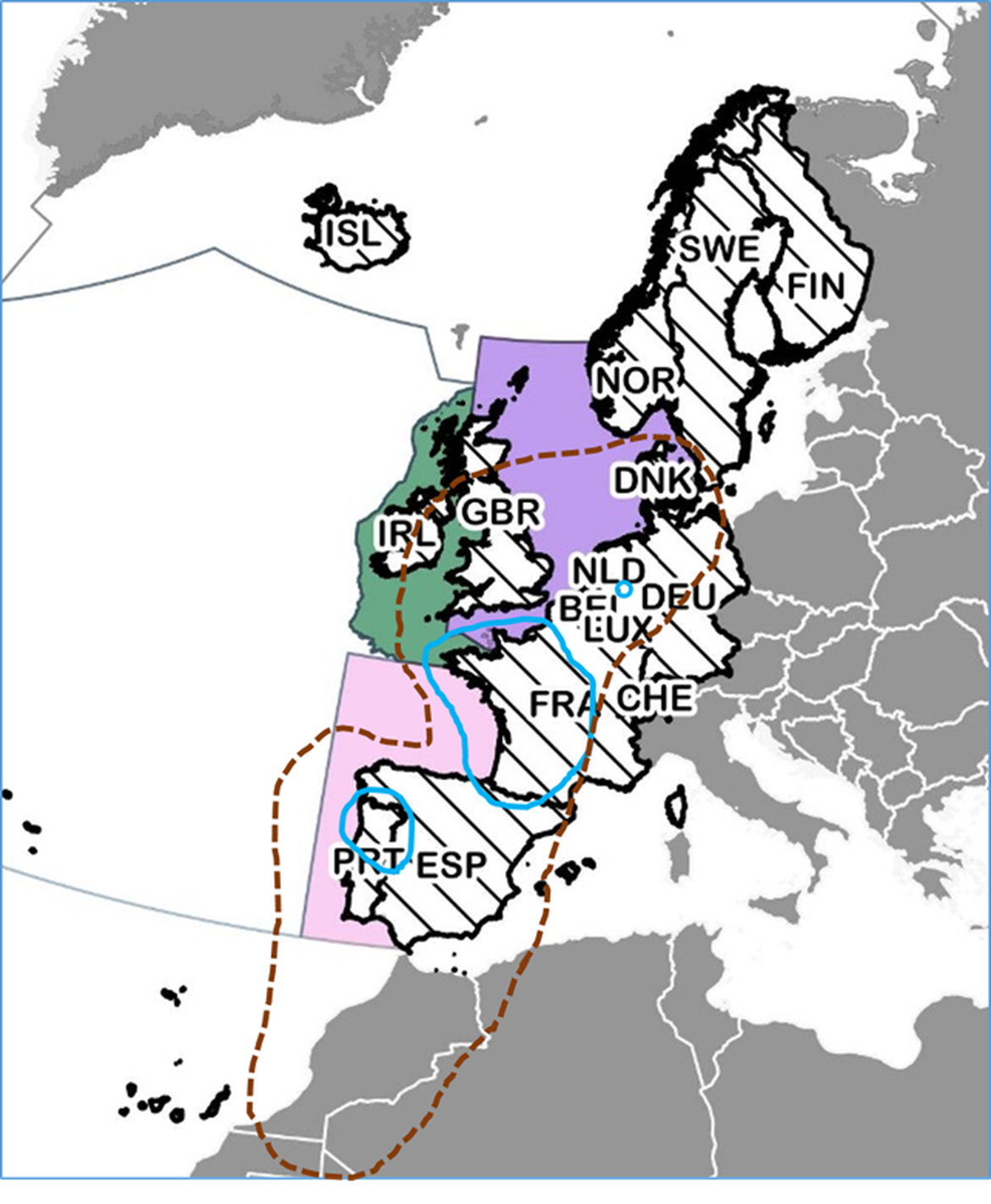
Figure 1: Historical (red dotted line) and current (blue line) primary distribution of Allis shad in the OSPAR Maritime Area (modified after Baglinière et al., 2003). The small blue circle refers to natural reproduction observed in the river Rhine (Germany) after a restocking program (Hundt et al., 2015).
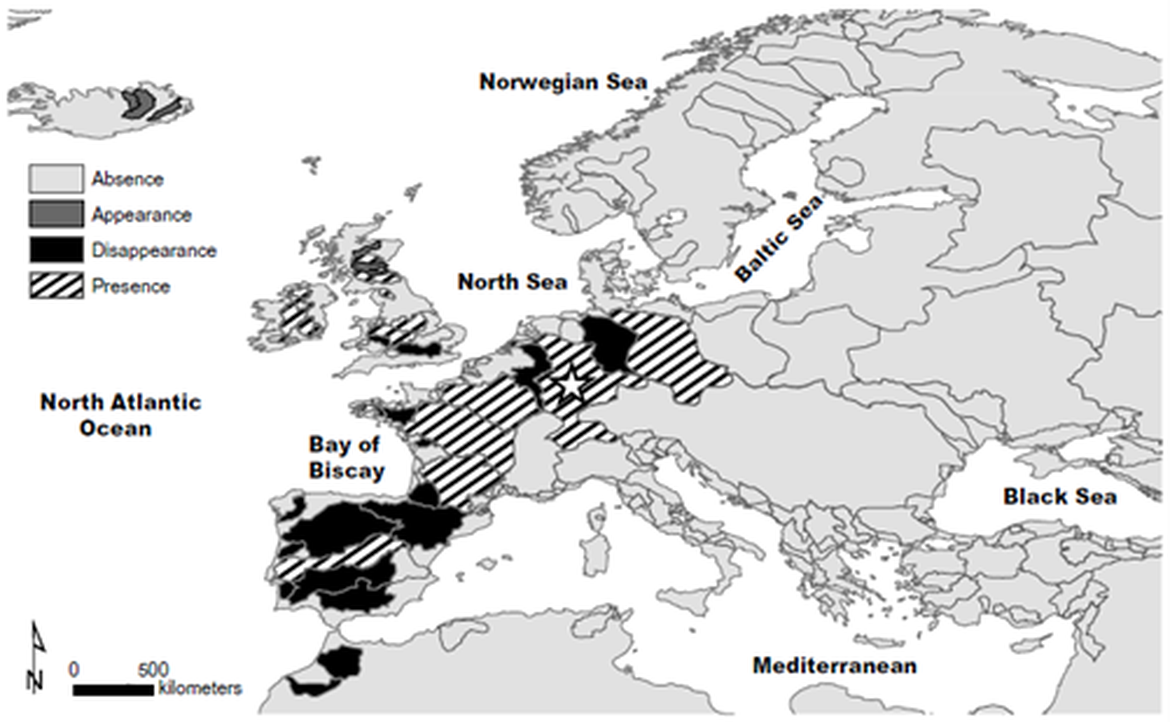
Figure 2: Projection of Allis shad (Alosa alosa) distribution in 2100 under a pessimistic climate change scenario. Adapted from Lassalle et al.(2008).
Population/Abundance
Abundance of Allis shad shows various trends depending on the geographical area. The biggest populations of Allis shad are located in France (Gironde and Loire) and Portugal (formerly in Minho and Lima rivers, and presently in the Mondego rivers). The collapse of the Allis shad population in the Gironde basin (Figure 3) appears to be the consequence of high estuarine mortalities due to the fishery in an initial phase, combined with an “Allee effect” (Rougier et al., 2012).
In Portugal (OSPAR Region IV), Allis shad population is critically decreasing (Azeiteiro et al., 2021) due to the building of dams for the last 50 years, particularly in the Minho River basin. For the last 15 years, if reference is made to Allis shad catches as a proxy, abundance in OSPAR Region IV seems quite stable, despite interannual variations (Figure 4) and shows recent signs of increasing abundance in the river Mondego (Almeida P.R., personal communication).
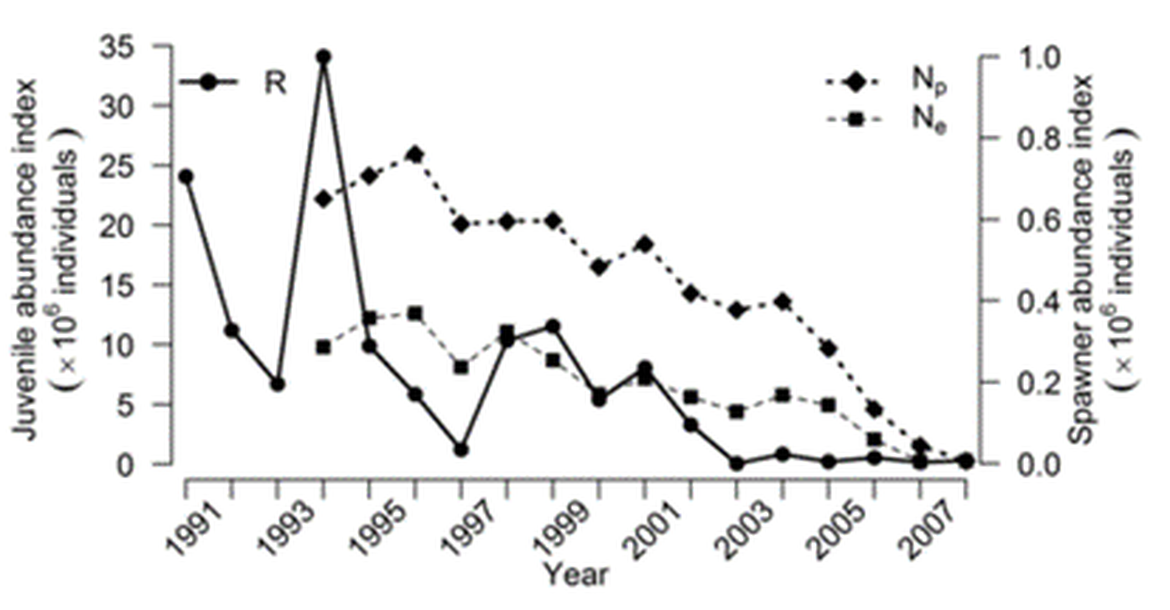
Figure 3: Abundance estimates of juveniles (left y-axis; R) and of potential and effective spawners (right y-axis; Np (estimate of potential spawners) and Ne (estimate of effective spawners), respectively), 1991–2008 in the Gironde river. Adapted from Rougier et al. (2021)
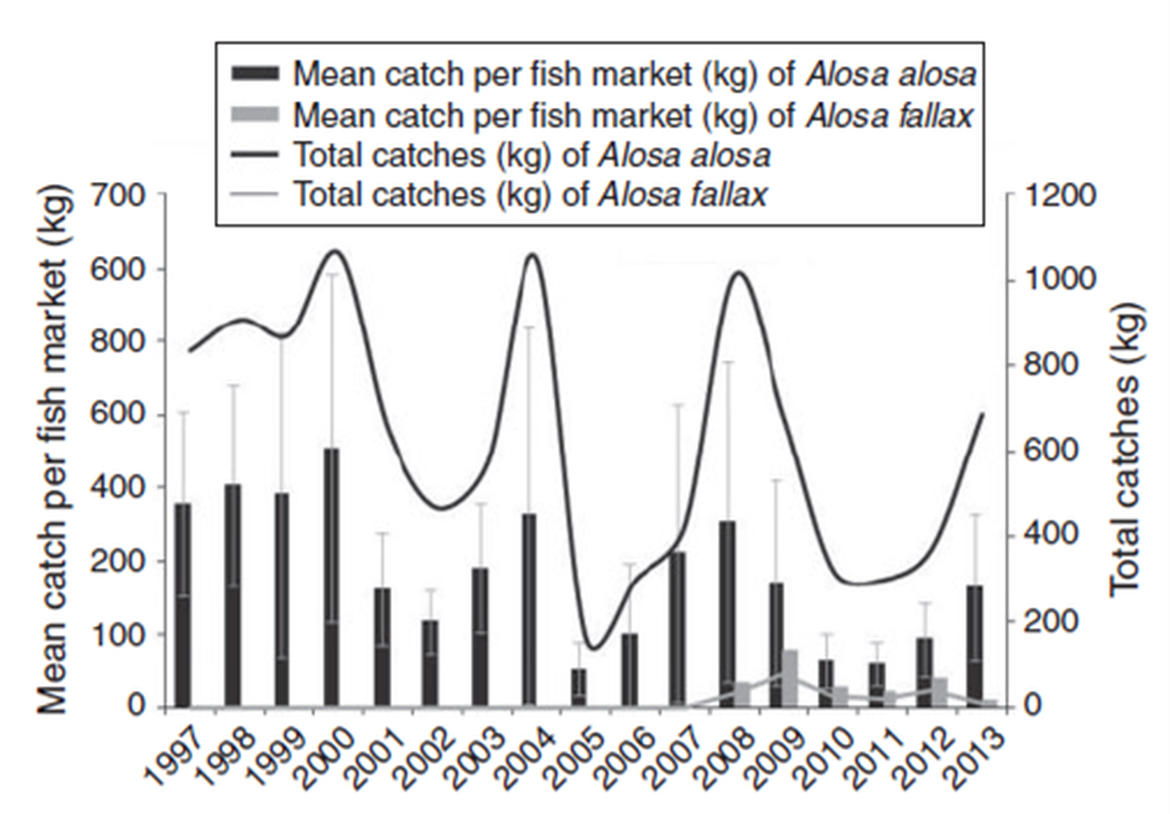
Figure 4: Cycling variation of A. alosa abundance with total catches and mean catch per fish market. Adapted from Nachón et al.(2015)
In France, the population shows a global decline (Figure 5) with a percentage change over time for the last 30 years estimated at more than - 95% (Legrand et al., 2020) with various trends in several river basins (Figure 6).
Method of assessment: 4 for Greater North Sea (OSPAR Region II); 1 and 4 for Celtic Sea (OSPAR Region III); 1, 4 and 5 for Bay of Biscay and Iberian Coast (OSPAR Region IV).
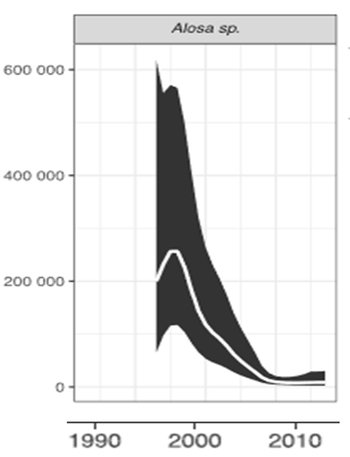
Figure 5: Predicted trends in fish counts from monitoring stations in France. Adapted from Legrand et al.(2020)

Figure 6: Predicted trends in fish counts from 12 monitoring stations in France. Y axis are log-abundance of estimated populations. Adapted from Legrand et al.(2020).
Condition
Given the rarity of Alosa alosa, there are insufficient data to examine the condition of the stock in the OSPAR Maritime Area, in terms of either length composition or sex ratio. A recent study nevertheless highlighted that there is no sign of degradation of condition in populations in Portugal where individuals appear to be bigger than individuals in populations of France (Mota & Antunes, 2011). Lassalle et al. (2008) reported a negative correlation between both age and size at maturity with latitude, suggesting a relation with sea temperature. Nevertheless, such results must be taken with caution as methods of sampling were different and data exhibited a strong variability between years of sampling.
Available data further suggests that hybridisation occurred between Allis and Twaite (Alosa fallax) shads and could be a regional source of loss of genetic diversity (Alexandrino et al., 2006; Stratoudakis et al., 2016; Taillebois et al., 2020). Such hybridization was reported for French and Portuguese populations and could impair reproduction potential, although it is still not clear how this threat impacts the species integrity evolutionarily and ecologically (Taillebois et al., 2020).
Method of assessment: 4 for Greater North Sea (OSPAR RegionII) and Celtic Sea (OSPAR RegionIII); 4 and 5 for Bay of Biscay and Iberian coast (OSPAR RegionIV).
Threats and Impacts
Obstacles to migrations, like dams, are the main historical and current threats for Allis shad populations, notably in France (Baglinière et al., 2003; Rougier et al., 2012). Due to major dam construction (five major dams were constructed along the Minho, (Azeiteiro et al., 2021)) there is also a strong decline in Portuguese populations (Figure 7) when landings are compared with the ones from the early 20th century. Additional threats include river canalisation, river pollution and boat noise and swell (Fricke, 2004).

Figure 7: Capture of Allis shad (units) in the Minho river; from (Azeiteiro et al., 2021).
A potential “Allee effect” has also been pointed out by Rougier et al. (2012). Notably because of very low density of Allis shad in Gironde river (in France), this could have impaired their reproduction process (Rougier et al., 2012).
Estuarine mortality due to fishing was highlighted to also be a significant threat especially for potential spawner populations (Almeida et al., 2018; Rougier et al., 2012; Stratoudakis et al., 2016). Rougier et al. (2012) estimated an exploitation rate, until 2009, of approximately 58% in the Gironde estuary, which is clearly an overexploitation of fish resources.
It also appears that, despite not currently being targeted in France by commercial fisheries, because of their pelagic behaviour, they are susceptible to significant by-catch by commercial fishing of mackerel, herring or anchovy (Trancart et al., 2014). Evidence of by-catch at sea is also available for Spain and Portugal (Nachón et al., 2015; Almeida et al., unpublished data).
Recently, the non-indigenous Wels catfish (Silurus glanis) diet has been assessed in Garonne river, France (Boulêtreau et al., 2021). Allis shad accounted for almost 90% of the identified prey items. Predation of Allis shad by Wels catfish has also been reported in Portugal (Ferreira et al., 2019). Considering the extension of the range of distribution of European catfish, this could be a significant threat and source of mortality in Allis shad freshwater habitats.
Measures that address key pressures from human activities or conserve the species/habitat
The following list of measures was derived from the Contracting Parties implementation reporting, complemented by national expert additions.
- By national legislation, the species is protected in France (Migratory Fish Management Plan), Ireland, the Netherlands (Nature Conservation Act), the United Kingdom (Wildlife and Countryside Act, Marine and Coastal Access Act);
- The 92/43/EEC Habitats Directive (DHFF) is applied in France, Germany, the Netherlands, the United Kingdom and Portugal;
- The EU Water Framework Directive 2000/60/EC;
- In France, management plans (COGEPOMI) are implemented regionally in eight counties (Bretagne, Loire, Adour, etc.). They aim to restore migration routes. A national program of restoration at Sélune river (starting in 2012) aims at restoring potential 700 km² of habitat suitable for several diadromous fishes, including Allis shad. In Germany, a reintroduction project is currently in progress for the Rhine river. In the Netherlands, a fish pass (at the Haringvliet) is designed to allow migratory fishes to swim upstream; these measures are part of a multi-year program. In Spain, measures regarding water quality are being implemented (EU WFD). In the United Kingdom, “Unlocking the Severn” has begun to address the problem of barriers to shad migration at Severn and Teme rivers. In Portugal, a pilot project was conducted in River Mondego, coupling habitat rehabilitation (fish pass construction) and monitoring with an integrated management approach of diadromous fisheries involving, not only authorities, but also fishermen and scientists on the decisions making process and establishing measures to ensure a sustainable exploitation of the resource. These measures included reducing the fishing season and establishing an intermediate fishing closure to ensure shad could reach the spawning grounds. This approach is now being implement in other systems, namely on the Vouga River Basin. Inland fishery for Allis shad is monitored on seven river systems through the annual independent surveys conducted near the fishermen community (Almeida et al., 2021; Stratoudakis et al., 2016);
- Allis shad occurs in 65 Marine Protected Areas (MPA), 15 being part of OSPAR network. These MPA’s have been specified in France (Natura 2000 framework), the Netherlands (notably Voordelta, Natura 2000), Spain, the United Kingdom (designation of six protected sites or SACS, part of OSPAR MPA);
- Monitoring programs are conducted in France (directed by OFB and INRAE), Germany (WFD), Ireland (National Biodiversity center and Marine institute), the Netherlands (at Wadden sea, Maas, Waal, Rijn, Ijssel, etc.), Spain, Portugal (coordinated by MARE-UEVORA projects Life Águeda- (LIFE16 ENV/PT/000411), An@dromos (MAR-01.03.02-FEAM-0002), Habitat restoration for diadromous fish in River Mondego, Portugal (PROMAR 31-03-02-FEP-5)), the United Kingdom (Environment Agency/Natural England, rivers Severn and Teme);
- Specific measures, communication and code of conduct for sport fishing were taken in the Netherlands and Portugal (control of illegal fishing and commercial fisheries restrictions).
Conclusion (including management considerations)
Allis shad populations have been under threat since the mid 19th century. Populations are more commonly located within OSPAR Regions III and IV but several recent studies suggested that small populations are located in OSPAR Region II. Restoring migration routes where Allis shad are currently concentrated (France and Portugal) should remain the priority (e.g. dam removal, adapting fish passes to facilitate Allis shad migration). Further reducing fish mortality both at sea and in rivers should also be prioritized. Stratoudakis et al. (2016) notably suggested the need to harmonize conservation effort across Portuguese freshwater basins using both legislation and controlling measures. A reduction of by-catch at sea would be beneficial, and could be supported by identifying seasonal high-risk areas. Illegal fishing may also be a growing threat for freshwater mortality and should be considered and managed as appropriate. Implementation of national measures to address these issues has been increasing in the past decade to ensure sustainable management.
From a climate change perspective, with the southern part of the Allis shad distribution predicted to be warmer and unsuitable for their survival, scientists and managers should identify future unsuitable areas (i.e. southern Europe) and locate potential suitable ones that will ensure reproductive success (Lassalle et al., 2008).
This current report of Allis shad population health in OSPAR Regions clearly suggests to keep the species on the list for priority action by OSPAR.
Knowledge Gaps
There is a considerable lack of knowledge on the adult marine life stage of both Alosa species Allis and Twaite. This could particularly impair the expert capability to understand modification in the geographical range and disentangle sources of mortality.
There are also growing concerns about newly emerging threats affecting Allis shad populations. New experimental evidence are emerging and suggest that anthropogenic aquatic noise could affect individuals development, physiology, and/or behaviour (Kunc et al., 2016). By creating electromagnetic fields and underwater noise, marine renewable energies development (e.g. tidal stream turbine or offshore wind farm) may affect diadromous fish behaviour. Knowledge is still very scarce but recent findings have highlighted that diadromous species can use the Earth's magnetic field for orientation and direction finding during migrations (Gill et al., 2012). There are some evidence in the literature of the effect of sound on migration behaviour for Alosa pseudoharengus (Dunning et al., 1992) and Alosa fallax (Gregory & Clabburn, 2003), but specific evidence is absent for Alosa alosa. Another newly reported threat is the introduction of invasive species in river basin where Allis (and Twaite) shad populations are present. For example in Ireland, a population of Corbicula fluminea (Asian clam), has been monitored since the 2010’s because of a growing concern on their potential effect on the local shad population (Caffrey et al., 2011).
Method used
Main source of information:
- Assessment lead was coordinated by France, namely J. Raitif (UMS OFB-CNRS-MNHN PatriNat) and A. Acou (UMS OFB-CNRS-MNHN PatriNat / Management of Diadromous Fish in their Environment OFB-INRAE-Institut Agro-UPPA, France).
- A common and joint France/Norway assessment method was used for anadromous species (Allis shad, sea lamprey and Atlantic salmon). An online meeting (17 of June 2021) and emailing were needed with national experts in order validate the use of EU Habitat Directive for the allis shad OSPAR assessment, complete data gathering, validate the methodology for assessment (spatial aggregation and integration) and review the final draft assessment.
- Experts involved in the assessment were:
Norway: T. Hesthagen
United Kingdom: A. Atterbury, C. Bean, C. Crundwell, R. Hillman, S. Walton
France: L. Beaulaton
Portugal : P. R. Almeida, A.F. Belo
Assessment is based upon:
a) Third party assessment (EU HD principally)
b) Literature studies
c) Direct or indirect data
d) Expert opinion of national experts
Alexandrino, P., Faria, R., Linhares, D., Castro, F., Le Corre, M., Sabatié, R., Baglinière, J. L., & Weiss, S. (2006). Interspecific differentiation and intraspecific substructure in two closely related clupeids with extensive hybridization, Alosa alosa and Alosa fallax. Journal of Fish Biology, 69(sb), 242‑259. https://doi.org/10.1111/j.1095-8649.2006.01289.x
Almeida, P. R., Arakawa, H., Aronsuu, K., Baker, C., Blair, S.-R., Beaulaton, L., Belo, A. F., Kitson, J., Kucheryavyy, A., Kynard, B., Lucas, M. C., Moser, M., Potaka, B., Romakkaniemi, A., Staponkus, R., Tamarapa, S., Yanai, S., Yang, G., Zhang, T., & Zhuang, P. (2021). Lamprey fisheries : History, trends and management. Journal of Great Lakes Research. https://doi.org/10.1016/j.jglr.2021.06.006
Almeida, P. R., Quintella, B. R., Mateus, C. S., Alexandre, C. M., & Pedro, S. (2018). Diadromous fish in Portugal : Status, threats and management guidelines. http://dspace.uevora.pt/rdpc/handle/10174/24562
Azeiteiro, U. M., Pereira, M. J., Soares, A. M. V. M., Braga, H. O., Morgado, F., Sousa, M. C., Dias, J. M., & Antunes, C. (2021). Dynamics of Two Anadromous Species in a Dam Intersected River : Analysis of Two 100-Year Datasets. Fishes, 6(2), 21. https://doi.org/10.3390/fishes6020021
Baglinière, J.-L., Sabatié, M. R., Rochard, E., Alexandrino, P., & Aprahamian, M. W. (2003). The Allis Shad Alosa alosa : Biology, Ecology, Range, and Status of Populations. 19.
Boulêtreau, S., Fauvel, T., Laventure, M., Delacour, R., Bouyssonnié, W., Azémar, F., & Santoul, F. (2021). “The giants’ feast” : Predation of the large introduced European catfish on spawning migrating allis shads. Aquatic Ecology,55(1), 75‑83. https://doi.org/10.1007/s10452-020-09811-8
Caffrey, J., Evers, S. L., Millane, M., & Moran, H. (2011). Current status of Ireland’s newest invasive species -the Asian clam Corbicula fluminea (Müller, 1774). Aquatic Invasions, 6(3), 291‑299. https://doi.org/10.3391/ai.2011.6.3.06
Dunning, D. J., Ross, Q. E., Geoghegan, P., Reichle, J. J., Menezes, J. K., & Watson, J. K. (1992). Alewives Avoid High-Frequency Sound. North American Journal of Fisheries Management, 12(3), 407‑416. https://doi.org/10.1577/1548-8675(1992)012<0407:AAHFS>2.3.CO;2
Ferreira, M., Gago, J., & Ribeiro, F. (2019). Diet of European Catfish in a Newly Invaded Region. Fishes, 4(4), 58. https://doi.org/10.3390/fishes4040058
Fricke, R. (2004). Fisch des Jahres 2004. Der Maifisch (Alosa alosa). Verband Deutscher Sportfisher e.V., Offenbach, 39 pp.
Gill, A. B., Bartlett, M., & Thomsen, F. (2012). Potential interactions between diadromous fishes of U.K. conservation importance and the electromagnetic fields and subsea noise from marine renewable energy developments. Journal of Fish Biology, 81(2), 664‑695. https://doi.org/10.1111/j.1095-8649.2012.03374.x
Gregory, J., & Clabburn, P. (2003). Avoidance behaviour of Alosa fallax fallax to pulsed ultrasound and its potential as a technique for monitoring clupeid spawning migration in a shallow river. Aquatic Living Resources, 16(3), 313‑316. https://doi.org/10.1016/S0990-7440(03)00024-X
Hillman, R. & Environment Agency. (2003). The distribution, biology and ecology of shad in South-West England. Environment Agency.
Hundt, M., Scharbert, A., Weibel, U., Kuhn, G., Metzner, K., Jatteau, P., Pies, A., Schulz, R., & Gergs, R. (2015). First evidence of natural reproduction of the Allis shad Alosa alosa in the River Rhine following re-introduction measures : Reproduction of alosa alosa in river rhine. Journal of Fish Biology, 87(2), 487‑493. https://doi.org/10.1111/jfb.12721
Jolly, M. T., Aprahamian, M. W., Hawkins, S. J., Henderson, P. A., Hillman, R., O’Maoiléidigh, N., Maitland, P. S., Piper, R., & Genner, M. J. (2012). Population genetic structure of protected allis shad (Alosa alosa) and twaite shad (Alosa fallax). Marine Biology, 159(3), 675‑687. https://doi.org/10.1007/s00227-011-1845-x
Kunc, H. P., McLaughlin, K. E., & Schmidt, R. (2016). Aquatic noise pollution : Implications for individuals, populations, and ecosystems. Proceedings of the Royal Society B: Biological Sciences, 283(1836), 20160839. https://doi.org/10.1098/rspb.2016.0839
Lassalle, G., Béguer, M., Beaulaton, L., & Rochard, E. (2008). Diadromous fish conservation plans need to consider global warming issues : An approach using biogeographical models. Biological Conservation, 141(4), 1105‑1118. https://doi.org/10.1016/j.biocon.2008.02.010
Lassalle, G., Trancart, T., Lambert, P., & Rochard, E. (2008). Latitudinal variations in age and size at maturity among allis shad Alosa alosa populations. Journal of Fish Biology, 73(7), 1799‑1809. https://doi.org/10.1111/j.1095-8649.2008.02036.x
Legrand, M., Briand, C., Buisson, L., Artur, G., Azam, D., Baisez, A., Barracou, D., Bourré, N., Carry, L., Caudal, A.-L., Charrier, F., Corre, J., Croguennec, E., Mikaélian, S. D., Josset, Q., Gurun, L. L., Schaeffer, F., & Laffaille, P. (2020). Contrasting trends between species and catchments in diadromous fish counts over the last 30 years in France. Knowledge & Management of Aquatic Ecosystems, 421, 7. https://doi.org/10.1051/kmae/2019046
Maitland, P. S., & Lyle, A. A. (2005). Ecology of Allis Shad Alosa alosa and Twaite Shad Alosa fallax in the Solway Firth, Scotland. Hydrobiologia, 534(1), 205‑221. https://doi.org/10.1007/s10750-004-1571-1
Merg, M.-L., Dézerald, O., Kreutzenberger, K., Demski, S., Reyjol, Y., Usseglio-Polatera, P., & Belliard, J. (2020). Modeling diadromous fish loss from historical data : Identification of anthropogenic drivers and testing of mitigation scenarios. PLOS ONE, 15(7), e0236575. https://doi.org/10.1371/journal.pone.0236575
Mota, M., & Antunes, C. (2011). First report on the status of Allis shad (Alosa alosa) in the Minho River (Northwestern Iberian Peninsula). Journal of Applied Ichthyology, 27(s3), 56‑59. https://doi.org/10.1111/j.1439-0426.2011.01853.x
Nachón, D. J., Mota, M., Antunes, C., Servia, M. J., Cobo, F., Nachón, D. J., Mota, M., Antunes, C., Servia, M. J., & Cobo, F. (2015). Marine and continental distribution and dynamic of the early spawning migration of twaite shad (Alosa fallax (Lacépède, 1803)) and allis shad (Alosa alosa(Linnaeus, 1758)) in the north-west of the Iberian Peninsula. Marine and Freshwater Research, 67(8), 1229‑1240. https://doi.org/10.1071/MF14243
OSPAR. (2008). Case reports for the Initial List of Threatened and/or Declining Species and Habitats in the OSPAR Maritime Area (Biodiversity series, p. 150 pp.).
OSPAR. (2009). Background Document for Allis shad Alosa alosa(OSPAR Commision report, p. 16 p. + annexes).
Rougier, T., Lambert, P., Drouineau, H., Girardin, M., Castelnaud, G., Carry, L., Aprahamian, M., Rivot, E., & Rochard, E. (2012). Collapse of allis shad, Alosa alosa, in the Gironde system (southwest France) : Environmental change, fishing mortality, or Allee effect? ICES Journal of Marine Science, 69(10), 1802‑1811. https://doi.org/10.1093/icesjms/fss149
Stratoudakis, Y., Mateus, C. S., Quintella, B. R., Antunes, C., & Raposo de Almeida, P. (2016). Exploited anadromous fish in Portugal : Suggested direction for conservation and management. Marine Policy, 73, 92‑99. https://doi.org/10.1016/j.marpol.2016.07.031
Taillebois, L., Sabatino, S., Manicki, A., Daverat, F., Nachón, D. J., & Lepais, O. (2020). Variable outcomes of hybridization between declining Alosa alosa and Alosa fallax. Evolutionary Applications, 13(4), 636‑651. https://doi.org/10.1111/eva.12889
Trancart, T., Rochette, S., Acou, A., Lasne, E., & Feunteun, E. (2014). Modeling marine shad distribution using data from French bycatch fishery surveys. Marine Ecology Progress Series, 511, 181‑192. https://doi.org/10.3354/meps10907
Sheet reference:
BDC2022/Allis shad




